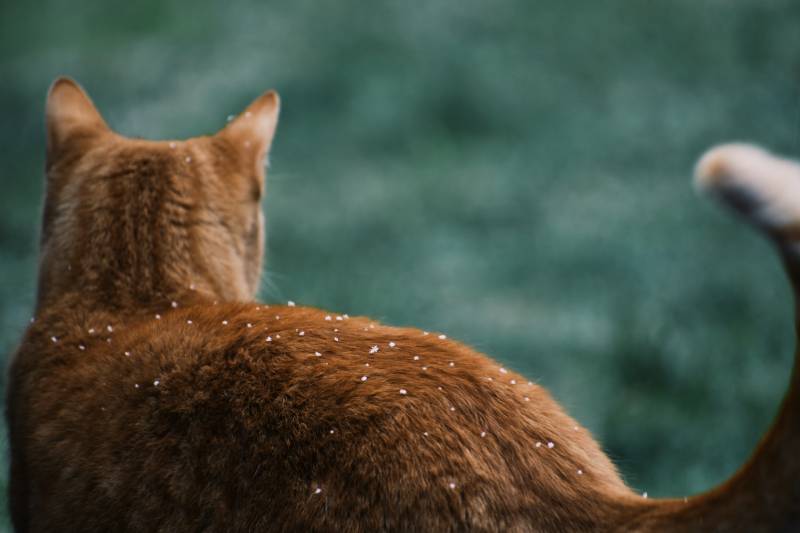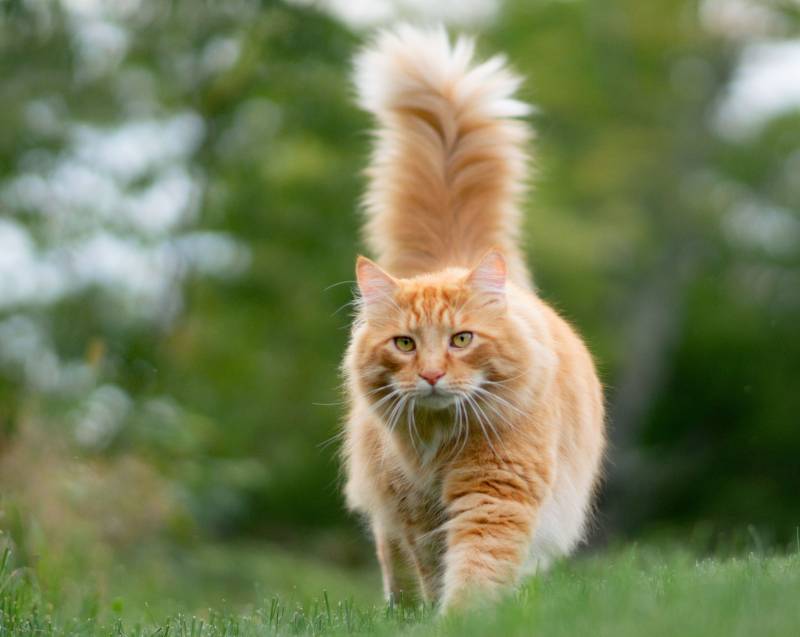Quick Navigation
Most cat owners are familiar with the cat’s vocal communication, such as purring, hissing, and meowing.
However, a few understand cats’ communication with their body.
Typically, cats communicate with their body more than they do with their vocals.
They use body language and behavior to talk to other cats and us.

Everything from their eyes, ears, tails, whiskers, and even toes give us clues on how they feel about what’s going on in their head.
Therefore, knowing to interpret what the cat is communicating is key.
For instance, if your cat is shaking its tail while urinating, this is a sign of discomfort, and you need to find out.
Here are some of the reasons why cats shake their tails while urinating:
Inflammation Of The Urinary Tract Or Cystitis
A cat urinary tract infection is typically characterized by unbearable and strenuous urination.
Also known as feline lower urinary tract disease, this infection can range from mild to serious.
If your cat has a urinary tract infection, he or she may urinate while standing, which may be mistaken for spraying.
When spraying, a cat will typically hold its tail up straight and quiver while urinating, frequently on an upright surface.
As a result, you should visit a vet right away if you notice that your cat is urinating while shaking its tail because of cystitis.
Aside from shaking its tail when urinating, the cat may even eliminate outside the litter box.
As expected, cats do an excellent job of hiding their sickness; that’s why you need to pinpoint several signs before the issue gets out of hand.
Aside from shaking its tail while urinating, other signs of a urinary tract infection include frequent grooming of the genitals, urinating outside of the litter box, gritty particles on the penis, and excessive urinating with little or no urine at all.
Solution
Unlike most cat diseases that need the attention of a veterinarian, cystitis doesn’t.
If you want to treat and manage cystitis, you will have to make environmental changes.
Additionally, you will have to change the cat’s diet.
And if these actions don’t help your cat, a vet will recommend using a supplement or antidepressant drug.
Bladder Stones
Another condition that can make your cat shake its tail during urination is bladder stones.
Bladder stones also called cystic calculi or uroliths, are rock-like formations of minerals that form in the urinary bladder.
Bladder stones can be a single stone, a large stone, or a collection of stones.
Besides, they can also vary in size, as they may feature a sand-like grain to gravel.
Usually, these stones develop because of a disease or inflammation in the bladder.
It is vital to identify this issue in your cat and have it diagnosed right away.
Apart from shaking its tail when peeing, a feline can also show other signs, such as becoming lethargic, excessive licking of the genital area, and frequent attempts to urinate.
On top of that, you may also see blood in the urine.
Solution
Typically, bladder stones are removed from your feline through surgical removal.
It is done to treat any blockage or to detect what the stone is made of.
Alternatively, the vet can also suggest waiting and seeing if the cat can pass the stone naturally.
In most cases, female cats usually pass the small bladder stones naturally.
When the stone is removed, your cat will return to urinating normally, and it won’t shake its tail when peeing.

Hypothyroidism
The thyroid is a gland found in the cat’s neck.
This gland produces several hormones that help to regulate many processes in your feline’s body, including metabolic rate.
So, if a disease, such as hypothyroidism attack the thyroid, the cat may change its behavior.
One of the signs of a cat with hypothyroidism is the cat shaking its tail while urinating.
Other signs include lethargy, constipation, weight gain, low body temperature, and cold intolerance.
The cat shakes its tail because the pee takes a long to come out; thus, the shaking.
Hypothyroidism in cats is usually caused by iodine deficiency, cancer, or congenital disease.
On top of that, the low level of thyroid hormones in cats leads to slow metabolism, which is not suitable for your cat.
Solution
If you suspect the cat is shaking its tail because of hypothyroidism, you should take it to a vet for a checkup.
If the situation is not difficult, the vet will recommend giving it a diet with reduced fat.
But if the issue is severe, then the vet will suggest using synthetic hormone supplements.
Kidney Failure
A healthy kidney in the cat gets rid of waste from the blood, regulates hydration and calcium, maintains a normal electrolyte balance, stimulates the production of red blood cells, and manages blood pressure.
So, if your cat experiences kid failure, many parts won’t function properly.
Due to poor metabolism, the cat will try shaking its tail to eliminate the stubborn urine.
Note that there are two types of kidney failure: acute renal failure and chronic kidney failure.
Acute renal kidney failure occurs for some days or weeks, while chronic kidney failure occurs for several months or even years.
Heart disease, dehydration, obstructions, bacterial infections, low blood pressure, and many other conditions can all lead to kidney failure in cats.
A cat with kidney failure may not only urinate while shaking its tail, but also experience weight loss, bad breath, vomiting, and excessive thirst.
Solution
Treatment of kidney failure is very challenging as the vet has to treat symptoms.
Besides, it also depends on the stage of the disease is in.
Regardless, this disease is still treatable, even though it takes a long to cure.
Diabetes Mellitus
If your cat is shaking its tail and at the same time urinating excessively, the issue may be Diabetes mellitus.
Diabetes mellitus is a disease of the pancreas. Two different types of cells make up the pancreas.
The beta cells produce the hormone insulin, while the other cells produce digestive enzymes.
So, if the pancreas fails to regulate blood sugar, it leads to diabetes mellitus.
Some of the main signs of a cat with diabetes mellitus include increased urination that makes the cat anxious, making it shake its tail during the process.
Also, the feline may have increased appetite, increased thirst, and loss of weight.
Note that most of these signs are difficult to detect in the early stages.
However, it is important to treat this ailment early.
Additionally, there are three types of diabetes mellitus in cats.
These include Type I diabetes mellitus, Type II diabetes mellitus, and Type III diabetes mellitus.
Solution
Treating diabetes mellitus in cats is quite a tedious process.
Nonetheless, when the cat can only be treated if it shows clinical signs of excess appetite, increased urination, weight loss, and increased thirst.
Anxiousness
Another reason why your cat may shake its tail while urinating is when it’s anxious.
On the contrary, if the cat is restless, it will also shake its tail as it urinates.
Several things can make your cat nervous, including illness/pain, infectious disease, or exposure to something dangerous.
Additionally, anxiety in your cat can be caused by a lack of proper socialization, a traumatic experience, or a history of abuse or neglect.
Solution
If your cat is anxious because of a disease or an infection, you should take it to a vet for a checkup.
But if it’s healthy and just anxious because of something in its environment, then you can get it something to scratch, such as a toy or an old scratching post.
Summary
So, if you notice that your cat is shaking its tail while urinating, you need to take t to the veterinarian and discover what’s troubling it.
Failure to do so, your furry friend may be in big trouble and you won’t like it at all.
Besides, some feline ailments are serious and may even lead to the death of your pet.
Therefore, if your cat is shaking its tail while urinating, it can be due to inflammation of the urinary tract, anxiousness, bladder stones, kidney disorder, thyroid, or diabetes mellitus.
Have the vet diagnose your cat in good time to save it from pain and suffering.

Purrfect n’ Pawesome is the brainchild of Amanda, who has been into researching and writing about pets to help other pet parents in nurturing their adorable pets. Currently, she runs Purrfect n’ Pawesome along with her team of experienced and dedicated pet experts. Along with being an awesome writer and entrepreneur, Amanda is a cat mom to two innocently spoiled cats, Balanca and Scruffy.
She has been writing about pet care and nurturing and wants to share her readers’ experiences, learnings, and knowledge.
Over the years, she had the opportunity to work with various pet owners having multiple breeds, and that exposure gave her experience and the lessons of a lifetime.
Her family, her entire universe revolves around her two cats, who give her endless support and inspiration to move ahead with her objectives in life. Amanda is a live example of a balanced approach to all parenthood questions we all face in life.
